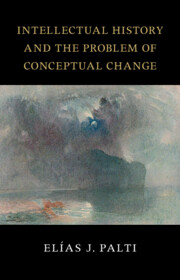Book contents
- Intellectual History and the Problem of Conceptual Change
- The Seeley Lectures
- Intellectual History and the Problem of Conceptual Change
- Copyright page
- Contents
- Preface
- Acknowledgments
- Introduction
- Chapter 1 Pocock, Skinner, and the “Historiographical Revolution”
- Chapter 2 The Republican Genealogy and the Normative Temptation
- Chapter 3 The Problem of Conceptual Change
- Chapter 4 Conceptual History
- Chapter 5 Koselleck’s Begriffsgeschichte
- Chapter 6 Hans Blumenberg and the Theory of Nonconceptuality
- Chapter 7 From Structuralism to Poststructuralism
- Chapter 8 Foucault’s Archaeology of Knowledge
- Chapter 9 The Archaeological Project and the Ignored Epistemic Mutation
- Chapter 10 Behind the Structures and the Subject
- Conclusion
- Epilogue
- Quoted Bibliography
- Index
Chapter 6 - Hans Blumenberg and the Theory of Nonconceptuality
Published online by Cambridge University Press: 02 May 2024
- Intellectual History and the Problem of Conceptual Change
- The Seeley Lectures
- Intellectual History and the Problem of Conceptual Change
- Copyright page
- Contents
- Preface
- Acknowledgments
- Introduction
- Chapter 1 Pocock, Skinner, and the “Historiographical Revolution”
- Chapter 2 The Republican Genealogy and the Normative Temptation
- Chapter 3 The Problem of Conceptual Change
- Chapter 4 Conceptual History
- Chapter 5 Koselleck’s Begriffsgeschichte
- Chapter 6 Hans Blumenberg and the Theory of Nonconceptuality
- Chapter 7 From Structuralism to Poststructuralism
- Chapter 8 Foucault’s Archaeology of Knowledge
- Chapter 9 The Archaeological Project and the Ignored Epistemic Mutation
- Chapter 10 Behind the Structures and the Subject
- Conclusion
- Epilogue
- Quoted Bibliography
- Index
Summary
Chapter 6 elaborates on Hans Blumenberg’s arguments highlighting the limits of conceptual history and the necessity of a more powerful theory to the account of conceptual change, or what he calls the metakinesis of the horizons of meaning. This leads him to elaborate his metaphorology that subsequently expanded to a theory of non-conceptuality. As the chapter shows, Husserl’s concept of “Lifeworld” provides the bases for his elaboration aimed at overcoming the limits of conceptual history. It then traces the origin of the difference between ideas and concepts back to Hegel’s Logic, and how Koselleck departs from it, breaking the logic of self-manifestation of the concept in Hegel. Finally, it analyzes how Blumenberg reaches his postulate of the rhetorical foundations of all conceptuality. In his perspective, metaphors and other forms of non-conceptuality perform a pragmatic function, providing answers to the questions on the totality of the world. They are, thus, the articulators of the “lifeworld.” However, the question now is how the horizons of meaning they establish are dislocated. Finally, the chapter discusses on the aporia implicit in the conceptualization of non-conceptuality.
- Type
- Chapter
- Information
- Intellectual History and the Problem of Conceptual Change , pp. 113 - 144Publisher: Cambridge University PressPrint publication year: 2024



